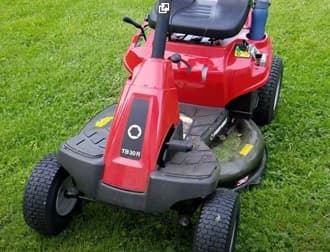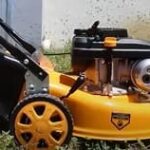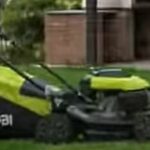As an Amazon Associate, this site earns commissions from qualifying purchases. For more information click here.
Rider mowers and lawn tractors have batteries that charge automatically while the engine is running. If the battery suddenly stops doing this, there are clearly some issues you need to look at. Since there are many ran why this can happen, we will examine the most likely and point out the solutions.
If your lawn mower battery is not charging, the battery is probably dead and can no longer transmit power. Other possible causes are a damaged diode, blown fuse and loose battery connectors. Replacing the battery and tightening the wires usually fixes the problem.
Before troubleshooting your rider mower, turn the engine off. Allow it to cool down. Wear safety gloves and follow all safety guidelines for handling lawn mowers. You should also have the owner’s manual with you for reference when looking for specific parts.
Damaged or Dead Battery
if the battery refuses to charge, it is probably dead or damaged. Mower batteries are designed to last for a long time, but they will eventually run out of power. Usually the battery does not die overnight. What you will notice is that it takes longer to charge each time and loses power quickly.
But if the battery is damaged, it can stop charging immediately. There are many ways this can happen like water gets in the casing, corrosion, extreme temperature, etc. Under these conditions your mower battery will cease working.
Solution. Use a multimeter to test the battery (we suggest Elekcity). If the result is 11.5V or less, you have to replace the battery. Mowers are particular about batteries so check your manual for what type should be used. Never use an incompatible or old battery because it can cause permanent damage.
Check the Battery Connectors and Wires
Next to the battery, the connectors, wires and charge lead should be checked. This is necessary to ensure that the wires can handle the current being transmitted. If the wires, connectors or ground lead have been corroded, you need to take action.
Solution. If the ground lead has corrosion, disconnect the wiring and turn the mower off. Replace the ground lead or use a wire brush to clean it. If the brush does not work, mix baking soda with water and apply on the rusted parts. Leave it there for 5 minutes at least. Wipe the paste off and try not to get any on the battery itself.
If the wires are loose, tighten them. If this does not work, the battery might already be damaged and has to be replaced.
Examine the output connector. Look for shorting, grounding or exposure. If you see any, replace immediately. Wires have to be replaced if the insulation starts wearing off. Any wire that has moisture is prone to damage and must no longer be used.
Check the Alternator
The alternator provides energy for the battery and is necessary to power the engine. It has a magnetized rotors that rotate in a fixed armature. This rotation produces DC (direct current) and is sent to the regulator rectifier. From there it goes into the battery.
These alternators get worn out eventually. In some cases it can be damaged and be unusable. If that happens the battery will no longer be able to receive a charge.
Solution. Either fix the alternator or replace it. You can check its condition using a multimeter. If the alternator is damaged, it is probably best to have it replaced. If you have the know-how you can fix it. But if not, you can bring the mower to a service center.
Related. Does your lawn mower have an alternator?
Faulty Electrical System
A battery lawn mower has its advantages. In particular it is smaller than other types and can fit in a car . But its efficiency depends on the electrical system. If this system breaks down the battery and the rest of the engine will not run.
Solution. Unlike the fuse or alternator, it is difficult to tinker with the electrical system. Mowers each have their own proprietary design so it can be hard to figure out. Unless you know what you are doing, tweaking the electronics could make things worse and void the warranty.
If the battery charging issue is related to the electronics, have it checked by a professional technician. These problems can be difficult to fix so have an expert check it. You can avoid this type of problem by investing in a high quality lawn mower. We like the Greenworks 24V Cordless because it works without a fuss.
Blown Fuse
A fuse protects the circuits in a lawn mower. It acts a barrier so excess electricity will not be able to get into the important parts of the system. If the fuse melts or blows up, this can cause other problems in the mower battery system. A fuse is found in all electrical systems and is an essential part of keeping electricity flowing smoothly.
Solution. The most common sign of a blown fuse is losing power. If the battery does not charge or the mower refuses to run, this is a good place to start checking. You can tell a fuse has blown or melted just by looking at it, so replace right away.
The location varies so refer to your manufacturer guide. It may also need a specific type so follow the guidelines provided in your manual.
Diode Problems
A diode keeps the electricity moving in a single direction. Lawn mowers have several diodes (called rectifiers) that turns the alternating current in the charging coil into direct current. Once converted into direct current or DC, it can be used to charge the battery.
Solution. If the diode has been damaged or worn out, the battery will not charge. You can check its status with a multimeter. If it no longer works, replace with a new one. Make sure the new diode is installed correctly, otherwise it will not work.
Related to this is the regulator rectifier. This is what allows the system to turn AC into DC. As the name suggests, it also regulates the power going into the battery to ensure that it is not overloaded. If the regulator is faltering, you can use a multimeter to verify.

Engine RPM is Too Low
Mower batteries need the engine to conduct charge. As the engine runs, the flywheel turns. There are magnets on the flywheel which generate current and stored in the battery. If the speed is too slow, the magnet cannot produce enough current to charge the battery.
Solution. Increase the RPM and the battery should be able to charge normally. You can increase engine speed using the governor or the throttle. Adjust the governor to increase the rev then try charging the battery again.
If that does not work, tighten the throttle cable. Doing so increases the air that gets into the system. Depending on your lawn mower, it might have other options to adjust the RPM. Check your manual for details.
Safety Guidelines
Do not replace or tinker with any of the engine parts unless you know what you are doing. You could hurt yourself or damage the mower even more.
If the engine is hot or smoking, turn the mower off right away. Wait for the engine to cool or the smoke to dissipate. Take a look at the engine and battery for signs of damage.
Use the mower only as directed in the instructions. This will extend its battery life and make charging easier.
When cleaning your rider mower, take care not to let any of the liquids get into the engine or battery. If a cleaning solution seeps in, this could permanently damage its charging properties.
Lawn mower battery chargers are built for long term use. It should last for years, but its longevity will depend on how it is used and what conditions.
Since the charging process is automatic, you do not have to do any oversight. But it pays to know how things like the alternator, diodes, rectifiers and other parts affect the charging process. So if there is an issue you will be able to find out the cause.

I love the outdoors and all the tools for maintaining gardens, yards and lawns. The only thing I am more passionate about is sharing what I know about garden and outdoor equipment.


